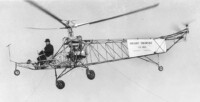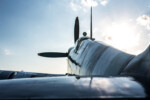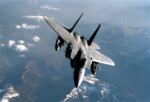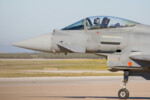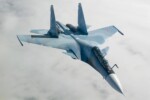The Types of Military Helicopters and What Makes Them Unique
2 January 2022 | Updated on February 05, 2024
Armed forces fighting the first global war between 1914-1918 relied on steam locomotives and horse-drawn wagons to get men and equipment to battlefields. But it was a slow and ineffective method resulting in battles losses where military transport corps could not move men or ammunition swiftly to vital locations.
Once dismissed as slow, ungainly, and exposed to ground fire, attack helicopters in the army have since evolved into fearsome weapons of destruction. They are the foremost low air assault and ground support aircraft for troops in battle. Military helicopter development has ensured rapid battlefield troop deployment, resulting in the efficient frontline supply while saving thousands of soldiers’ lives.
Although the different helicopters in the military have different uses, it is common for them to share similar airframe designs and engines. One of the most successful helicopters in the army, the Bell UH-1 Iroquois utility helicopter, was developed into other variants, including the AH-1 Cobra attack helicopter and the HH-1K ‘kilo’ search and rescue helicopter.
Prepare to be informed and entertained as you read about the different types of military helicopters, their uses, and other defining characteristics.
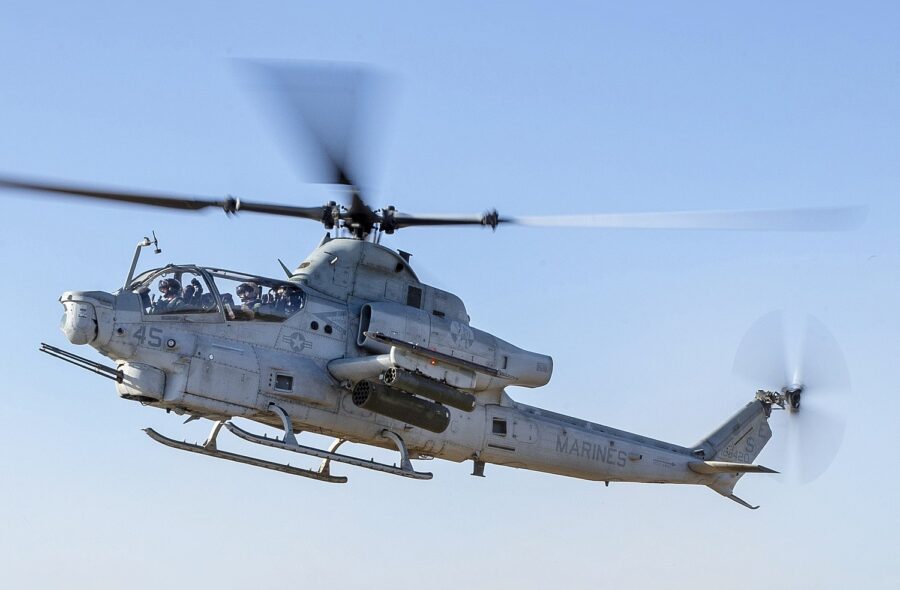

1. Attack Helicopters
Attack helicopters are the most lethal helicopter types. These military helicopters are designed to engage ground-based enemy targets with an assortment of autocannons, machine guns, rockets, and a variety of missiles. Attack helicopters have a similar primary mission as ground attack fighter jets. Still, they operate for more extended periods and fly much lower, giving pilots a closer shot at enemy positions.
Popular examples of attack helicopters
Mil Mi-24 (Hind)
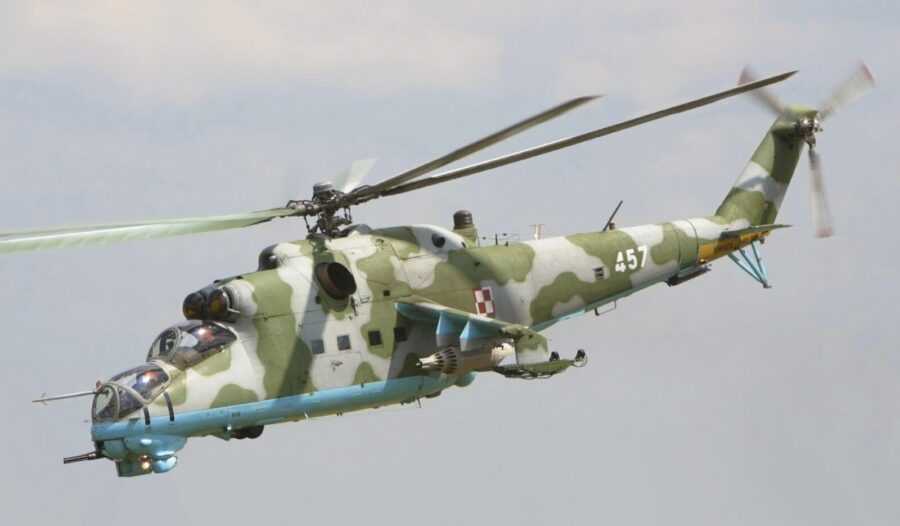

Photo by Cezary Piwowarski
- Manufacturer: Mil Helicopter Plant
- Airspeed: 335 kph (208 mph)
The Mil-24 is a Russian attack military helicopter also called the flying tank. Introduced in 1972, this armored ground attack helicopter type is in service with the Russian Air Force and the militaries of 48 countries. Mil-24s are equipped with various weapons, including machine guns, twin-barrel autocannons, rocket and missile launchers, multiple bombs, and antisubmarine munitions.
Boeing AH-64 Apache
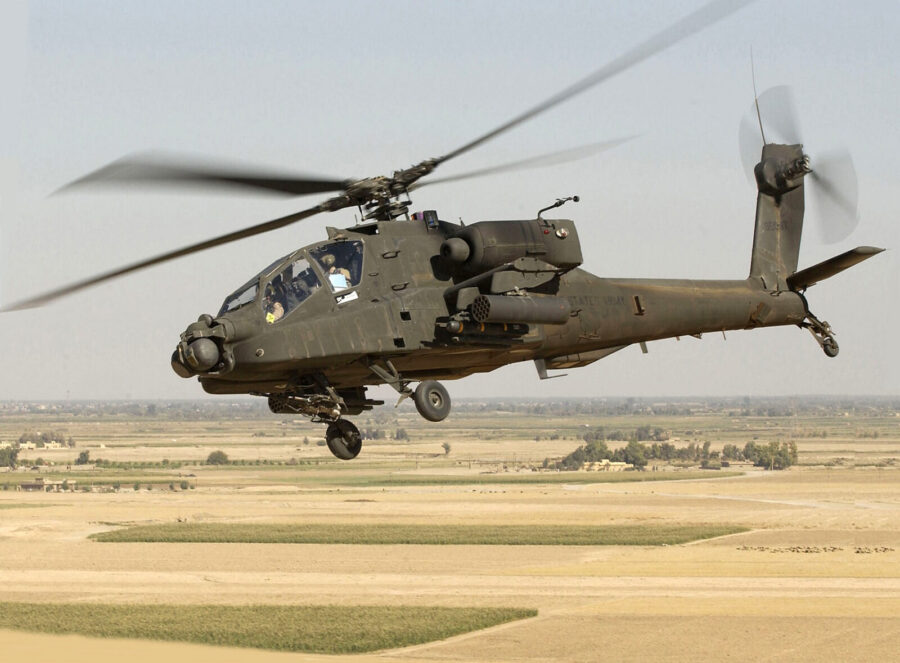

Photo Courtesy of U.S. Army
- Manufacturer: Boeing Defense Space and Security
- Airspeed: 365 kph (227 mph)
Introduced in April 1986, the Apache is one of the most successful attack helicopters in the United States army. It is an all-weather aircraft exported and operated by Israel, Egypt, and the Netherlands air forces. Its weapons include a 30 mm (1.18 in) M230 chain gun mounted between the wheels and a combination of several AGM-114 Hellfire missiles and Hydra 70 rockets. Standard equipment on the AH-64 includes night vision equipment and Lockheed Martin’s Arrowhead (MTADS) targeting system.
Eurocopter Tiger
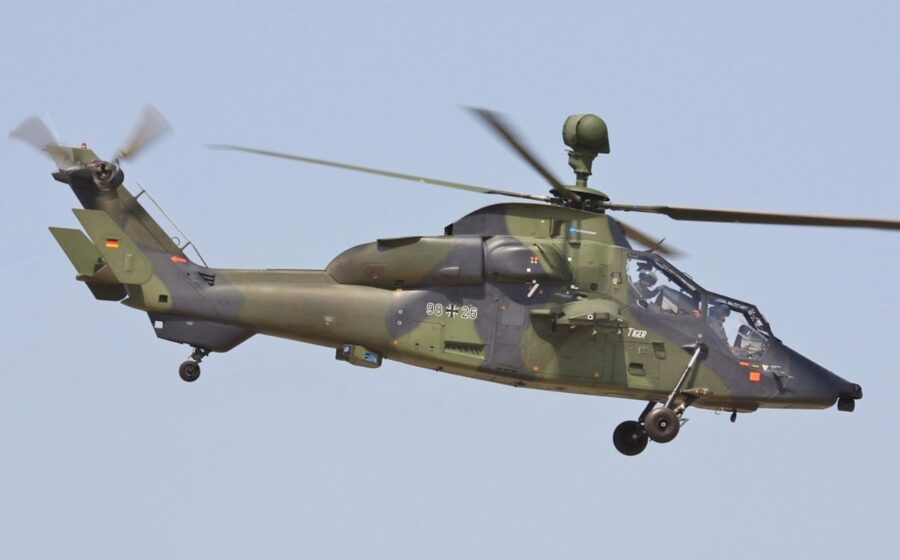

Photo by Alan Lebeda
- Manufacturer: Eurocopter/Airbus Helicopters
- Airspeed: 315 kph (196 mph)
The Eurocopter is a twin-engine, four-blade attack helicopter with stealth technology introduced in 2003. Originally designed as an anti-tank helicopter, the Eurocopter is currently a multirole attack helicopter operated by several European countries’ armies with combat deployment in Afghanistan, Libya, and Mali. The Eurocopter carries a wide assortment of weapons, including several gun pods, anti-tank weapons, 70mm and 68 rockets, air-to-air and air-to-surface missiles.
2. Transport Helicopter
The military’s transport and cargo helicopters are the primary resources for troop and cargo movement between battle frontlines and ground or sea support bases. They are especially vital to any war effort because they can deploy troops or material in almost any location, including dense jungles where troops can rapidly deploy by abseiling or roping.
There are three types of transport helicopters:
- Air assault military helicopters can move small troop numbers, typically an infantry squad including their gear.
- Medium transport helicopters in the army can move more significant troop numbers, usually a platoon and their equipment. Medium-lift helicopters also use an undercarriage sling to lift artillery or light vehicles.
- Heavy lift helicopters are the largest military helicopters in the world. These helicopter types are designed to lift around 80 troops with their gear. They also can carry heavier armored fighting vehicles in their internal cargo bay or as a slung load.
Transport helicopters can carry various weapons, including doors and wings, mounted machine guns and missiles for protection during flight, and enemy fire suppression in landing zones.
Common examples of military transport helicopters
Boeing Vertol CH-46 Sea Knight
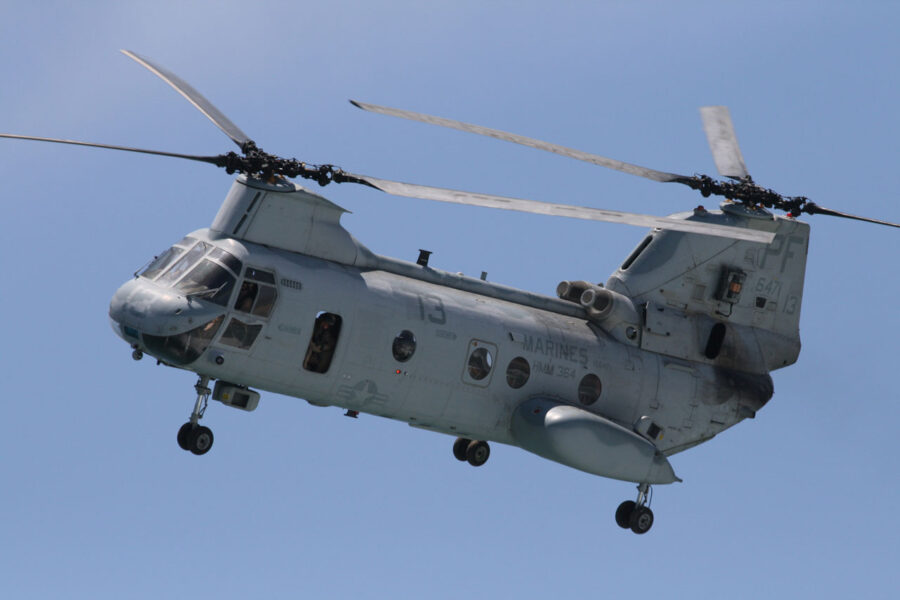

Photo by Andrew Schmidt
- Manufacturer: Boeing Vertol Aircraft
- Airspeed: 267 kph (166 mph)
- Capacity: 24 troops/ 15 stretchers/ 3,200 (7,000 lb) payload
- Max Takeoff Weight (MTOW): 11,022 kg (24,300 lb)
A worthy successor to the H-21 ‘Flying Banana,’ the CH-46 Sea Knight is a tandem rotor medium-lift transport helicopter operated by the United States Army and Navy. From its debut in 1964 during the Vietnam war, the Sea Knight was the United States Marines primary troop transport helicopter until its frontline retirement in 2014. Variants of the Sea Knight remain in limited service with the Japanese and Canadian air forces.
Boeing CH-47 Chinook
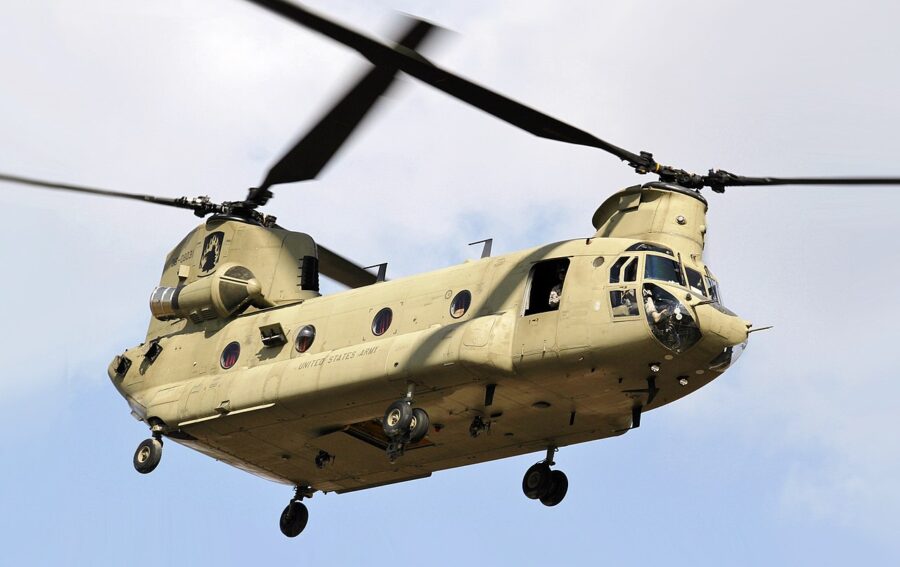

Photo by SPC Glenn Anderson
- Manufacturer: Boeing Defense Space and Security
- Airspeed: 315 kph (196 mph)
- Capacity: 35 troops/ 24stretchers/ 10,886 kg (24,000 lb) Payload
- Max Takeoff Weight (MTOW): 22,860 kg (50,000 lb)
This heavy-lift, twin-engine, tandem-rotor military helicopter has been the workhorse of the United States Army since its launch in 1962. Aside from being one of the largest military helicopters, the CH-47 is also one of the fastest. It remains in active service with the air forces of several countries, including India, the Netherlands, Singapore, and Spain. The CH-47 has multiple cargo loading bays for easier and faster cargo loading, including three external ventral hooks for undercarriage slung loads.
Aérospaliate SA 321 Super Frelon ‘Super Hornet’
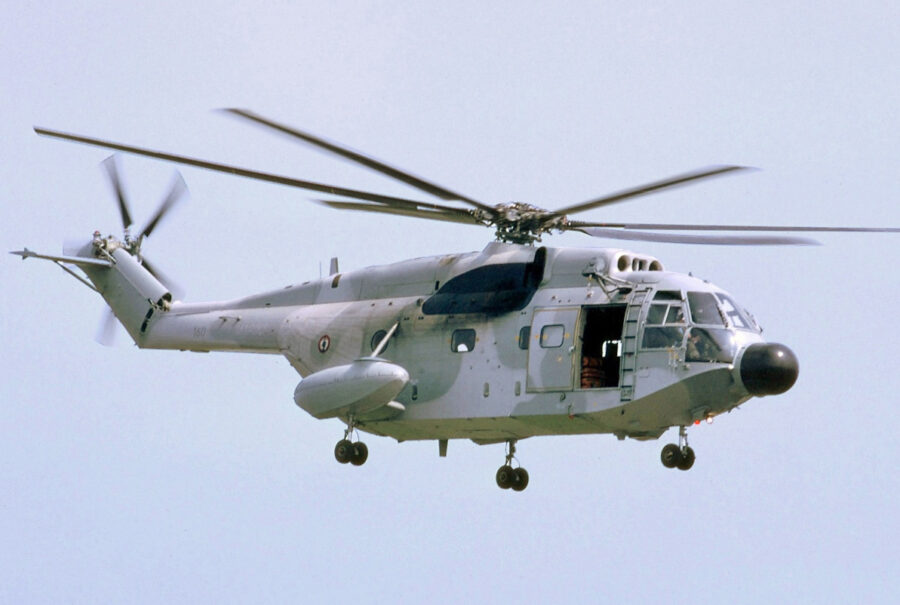

Photo by Rob Schleiffert
- Manufacturer: Sud Aviation/ Aérospaliate
- Airspeed: 275 kph (171 mph)
- Capacity: 24 troops/ 15 stretchers
- Max Takeoff Weight (MTOW): 13,000 kg (28,660 lb)
The Super Frelon is a heavy lift transport helicopter that was the most powerful and fastest military helicopter at its launch in 1966. Initially produced by Sud-Aviation before its acquisition by French Aérospatiale. The Super Frelon is in service with the French Navy and People’s Liberation Army Naval Air Force.
3. Observation Helicopters
Observation helicopters in the military have come a long way from the aerial reconnaissance balloons of the past century. The primary function of observation helicopters in the army is to spot hidden enemy positions and call in an airstrike or artillery fire. Spotting the enemy from early military observation helicopters depended on the pilot’s keen eyesight, and the aircraft had large rounded and well-glazed cockpits providing pilots with excellent visibility.
However, modern observation military helicopters are equipped with sophisticated optical sensors and communication systems, enabling them to perform their missions effectively. These include forward-looking radars, low-light television cameras, and advanced weapons targeting radars.
Observation helicopter types are armed with an array of weapons to destroy the enemy’s reconnaissance assets and prevent them from becoming sitting ducks to ground fire. These include autocannons and machine guns, laser-guided missiles, and bombs.
Popular examples of observation helicopters
Kawasaki OH-1 “Ninja”


- Manufacturer: Kawasaki Aerospace Company
- Airspeed: 278 kph (173 mph)
- Service Ceiling: 4,880 m (16,010 ft)
The Kawasaki Ninja is a Japanese observation and armed scout military helicopter in service with the Japan Ground Self-Defense Force (JGSDF). The Kawasaki Ninja can be armed with various missiles and anti-tank weapons. Standard equipment includes an autopilot system leaving the crew to focus on their primary mission, forward-looking infrared sensor, laser rangefinder, and color TV camera mounted in a roof sensor turret.
Bell OH-58 Kiowa
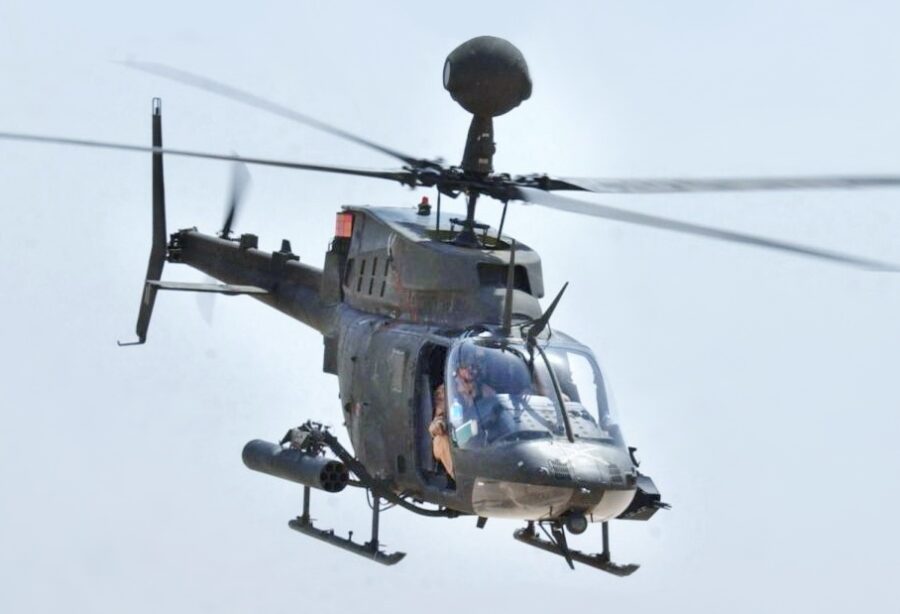

U.S. Army photo
- Manufacturer: Bell Helicopters
- Airspeed: 204 kph (127 mph)
- Service Ceiling: 4,575 m (15,000 ft)
Launched in 1969, the OH-58 Kiowa is an observation military helicopter with utility and direct fire support multirole functions. It is equipped with the Mast Mounted Sight MMS developed by Bell Aerospace & Technologies. It combines television and thermal imaging systems, and Laser Rangefinder/Designator (LRF/D), providing the aircraft with night and daylight all-weather operations capability. It was operated by the United States Army until its retirement in 2020, with several combat deployments in the Vietnam War, Gulf War, Iraqi War, and Afghanistan.
Aérospatiale Gazelle


Photo by Wikipedia user Airwolfhound
- Manufacturer: Sud Aviation/ Aérospaliate
- Airspeed: 310 kph (190 mph)
- Service Ceiling: 5,000 m (16,000 ft)
First introduced in 1973, the Aérospaltiale Gazelle is a scout helicopter type with transport and light attack multirole functionality. It is in service with the armies of several countries with combat deployment in the Syrian Civil War, 1982 Lebanon War, Iran-Iraq War, and the Gulf War.
4. Maritime Helicopters
Maritime helicopters are naval helicopter types designed to operate from sea bases, e.g., aircraft carriers and destroyers. And are equipped to perform multi-role missions, including anti-submarine warfare, troop and cargo transport, anti-shipping deterrent operations, maritime search and rescue, and surveillance.
Several maritime military helicopters are mid/heavy transport variants or utility military helicopters adapted for naval operations. These variants typically have unique features like anti-saltwater corrosion paint protection, additional fuel tanks for improved operating range, engine snorkels preventing water ingestion, and sea ditching capabilities.
Purpose-built maritime helicopter types often feature many composite materials in their fuselage and rotor blades to reduce weight, increase their range, and prevent corrosion. Additional features include space-saving designs like folding rotors and hinged tails for practical storage in compact spaces aboard ships and aircraft carriers.
Examples of maritime helicopters include
Sikorsky SH-60/MH-60 Sea Hawk
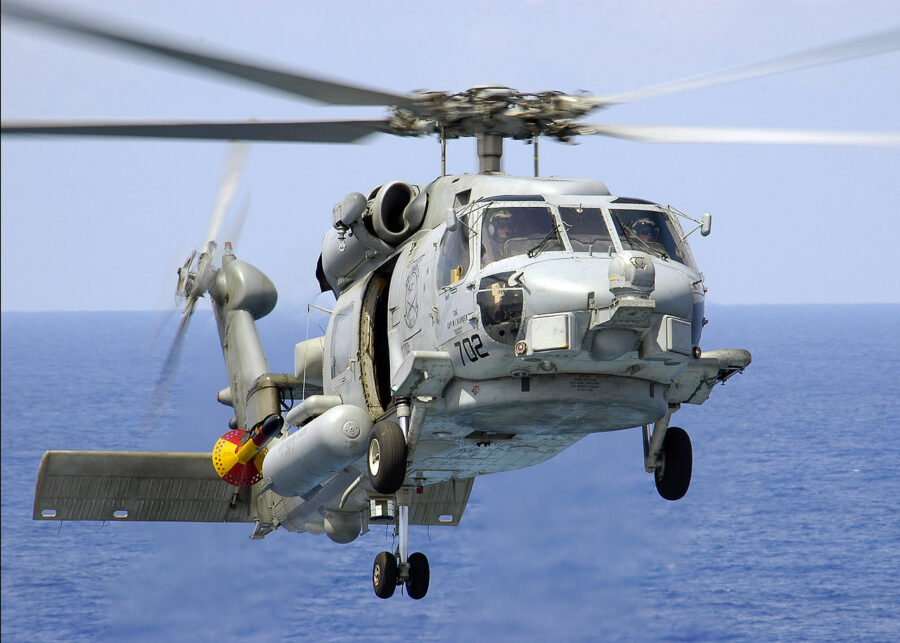

- Manufacturer: Sikorsky Aircraft
- Airspeed: 330 kph (210 mph)
- Capacity: 5 troops/ 2,700 kg (6,000 lb) external payload/ 1,900 kg (4,100 lb) internal payload
- Range: 830 km (520 miles)
The SH-60 Sea Hawk is an adaptation of the Sikorsky S-70, and it shares similar design features with the UH-60 Black Hawk military helicopter. The SH-60 Sea Hawk is in service with the United States Navy and the naval forces of Australia, Turkey, and Spain. SH-60s can deploy from large aircraft carriers and smaller naval vessels to perform various multi mission operations. These include anti-submarine warfare, air-sea rescue, naval special warfare insertion, anti-surface warfare, and medical evacuations.
AgustaWestland AW101
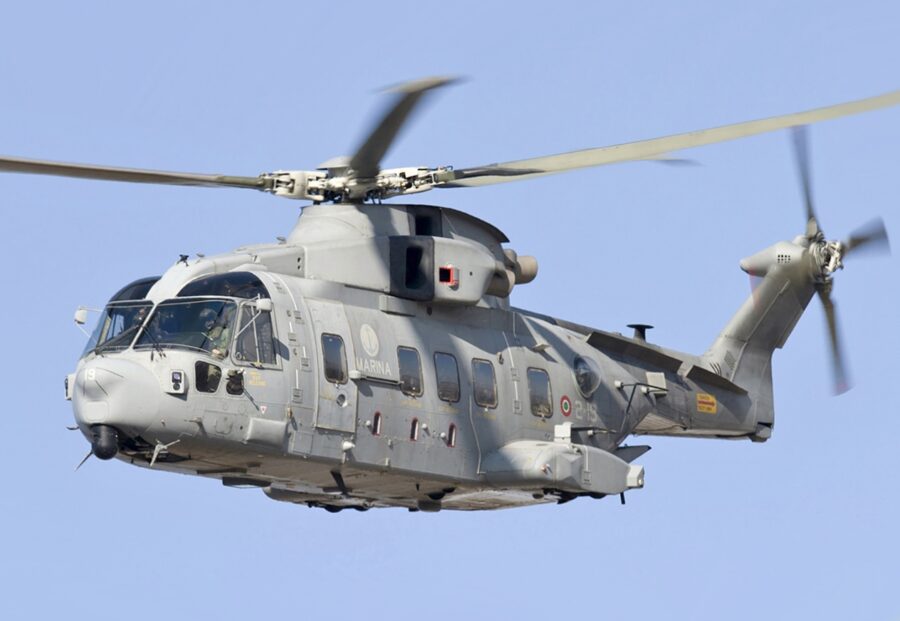

Photo by Peng Chen
- Manufacturer: AgustaWestland Helicopters
- Airspeed: 309 kph (192 mph)
- Capacity: 26-45 troops/ 4-16 stretchers/ 3,050 kg (6,724 Ib) internal payload/ 5,520 kg (12,169 Ib) external payload 2,700 kg (6,000 lb) external payload/ 1,900 kg (4,100 lb) internal payload
- Range: 833 km (518 miles)
The AgustaWestland AW101 helicopter is a medium-lift naval helicopter developed by the United Kingdom and Italy. It was launched in 1999, and it is in service with Royal NAvy, Italian NAvy, and the Danish Air Force. The AW101 is designed with the multimission capability to perform various roles, including air-sea rescue, anti-submarine warfare, and maritime utility operations.
Sikorsky SH-3 Sea King
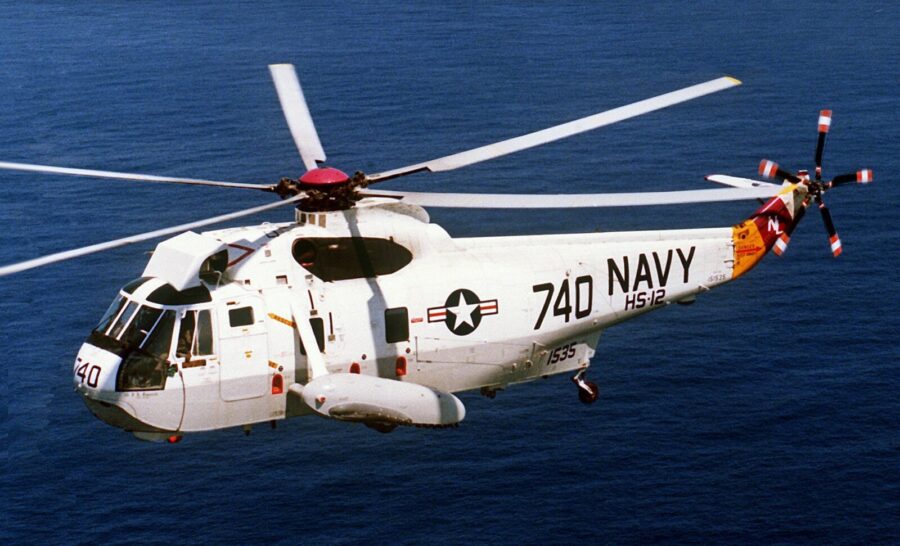

US Navy photo
- Manufacturer: Sikorsky Aircraft
- Airspeed: 219 km/h (136 mph)
- Capacity: 26 troops/ 15 stretchers
- Range: 1,005 km (625 miles)
The SH-3 Sea King is one of the most effective anti-submarine warfare (ASW) platforms the United Navy operates. It was conceived to challenge the growing threat of Soviet nuclear-powered submarines. It was designed to integrate the hunter and killer multirole operations previously performed by multiple ASW military helicopters.
5. Search and Rescue Helicopters
The earliest search and rescue helicopter types debuted during the Second World War as German and Allied forces recognized the advantages of using helicopters to airlift downed pilots and wounded troops from the remote battlefields of Southeast Asia. Current search and rescue helicopters have significantly evolved from their World War II predecessors with purpose-built state-of-art avionics and radar systems to help the pilots locate stranded personnel in rugged terrain or inclement weather conditions.
Popular examples of search and rescue helicopters
Sikorsky MH-60G/HH-60G Pave Hawk
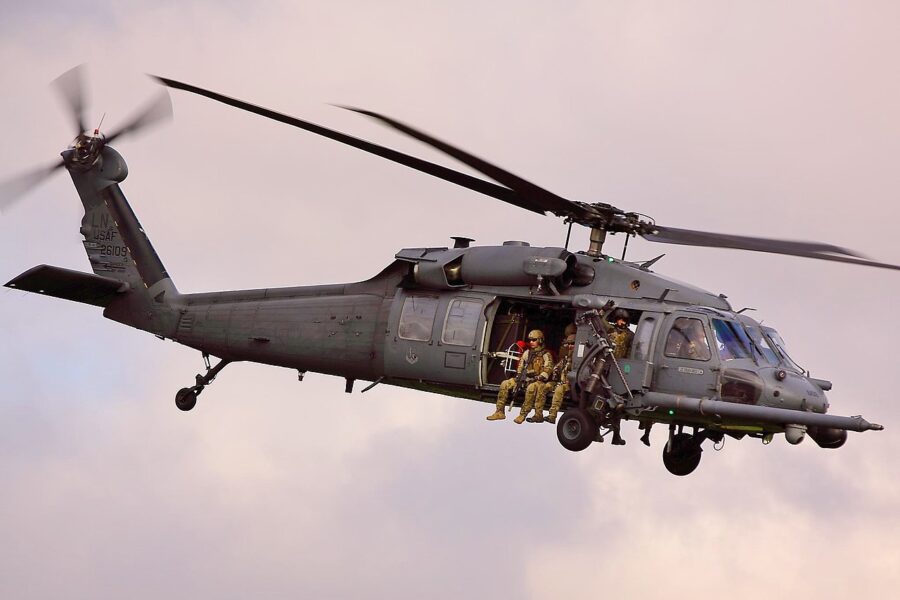

Photo by Tim Felce (Airwolfhound)
- Manufacturer: Sikorsky Aircraft Corporation
- Airspeed: 294 kph (183 mph)
- Capacity: 12 troops+cargo
- Range: 600 km (373 miles)
The Sikorsky Pave Hawk is a dedicated search and rescue military helicopter operating with the United States Air Force and the Republic of South Korea Air Force. It shares a similar airframe with the famous army utility helicopter, the UH-60 Black Hawk. However, it is equipped with different avionics systems. The United States Airforce Pave avionics system provides the Pave Hawk with all-weather, day, and night operational capabilities for troop insertion, recovery, and search and rescue in hostile territory.
Sikorsky S-61R
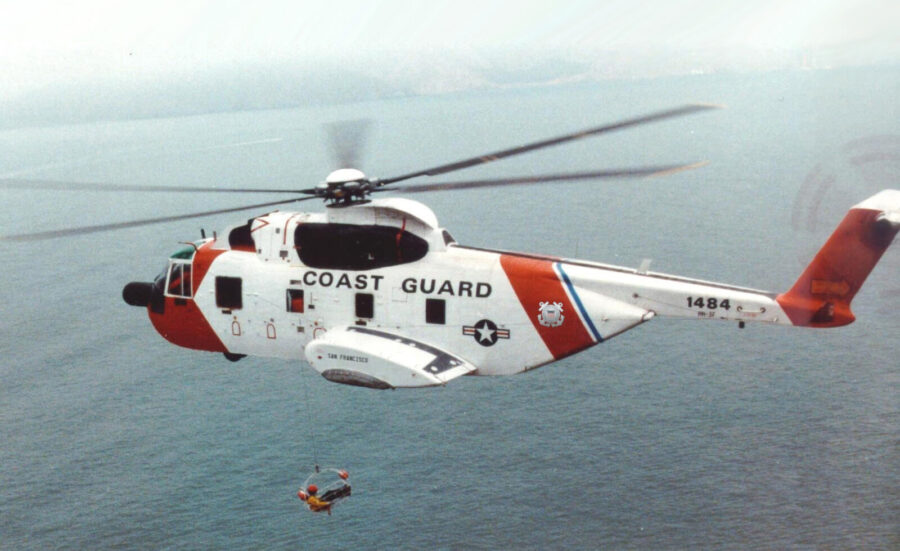

United States Coast Guard photo
- Manufacturer: Sikorsky Aircraft Corporation
- Airspeed: 295 kph (165 mph)
- Capacity: 28 troops/ 15 stretchers/ 2,948 kg (6,500 Ib) payload
- Range: 1,443 km (896 miles)
The SR-61 is a search and rescue helicopter in the military that can also function as a medium-lift helicopter transport. Introduced in 1961, the SR-61 operates with the United States Air Force, the Coast Guard, and the Tunisian Air Force. Common variants of the SR-61 include the CH-3C/E Sea King, the HH-3E known as “Jolly Green Giant,” and the HH-3F “Pelican” of the Coast Guard.
Sikorsky R-4
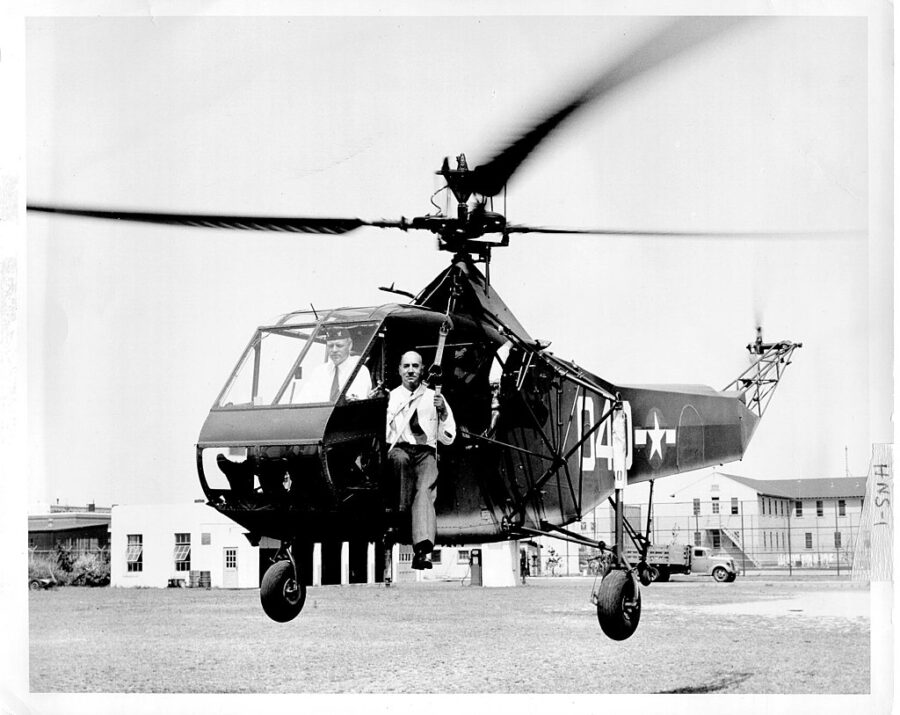

U.S. Coast Guard photo
- Manufacturer: Sikorsky Aircraft Corporation
- Airspeed: 121 km/h (75 mph)
- Capacity: 1 external stretcher
- Range: 210 km (120 miles)
Also called the “Hoverfly,” the Sikorsky R-4 was introduced in 1942 as a twin-seater, single-engine operated by the United States Army Air Forces and the Royal Air Force during the Second World War. It is the world’s first mass-produced helicopter and search and rescue helicopter. Between April 22 and 23rd 1944, the R-4 performed the first helicopter combat rescue mission by airlifting a downed pilot and three British troops in the China-Burma-India theater.
6. Utility Helicopter
Utility helicopters in the army are multirole helicopter types designed with multi mission capabilities. These include aerial attack, command, control, light to medium troop transport, search and rescue, medical evacuation, and surveillance. They are the most common military helicopter types, with most military transport and maritime helicopters being utility helicopters designed with multi-role functionalities.
Common examples of utility helicopters
Aérospatiale Alouette III


Photo by Alan Wilson
- Manufacturer: Sud Aviation/ Aérospatiale
- Airspeed: 210 kph (130 mph)
- Capacity: 5 passengers
- Range: 540 km (340 miles)
The Aérospatiale Alouette III is a light utility military helicopter introduced in 1960. It is currently in service with several militaries and air forces, including France, Portugal, India, and South Africa. It is one of the most successful utility helicopter airframes with over 200 units in service globally.
The Aérospatiale Alouette III was designed for various multimission roles, including aerial reconnaissance, air-sea rescue, transport, aerial attack, medical evacuation, training, and liaison. Standard armaments include door-mounted machine guns, autocannons, anti-tank missiles, and anti-submarine torpedoes.
Interesting fact: Sud Aviation Alouette III was the successor of the Alouette II, which in 1955 became the first helicopter to be produced with a turbine engine.
Sikorsky UH-60 Black Hawk
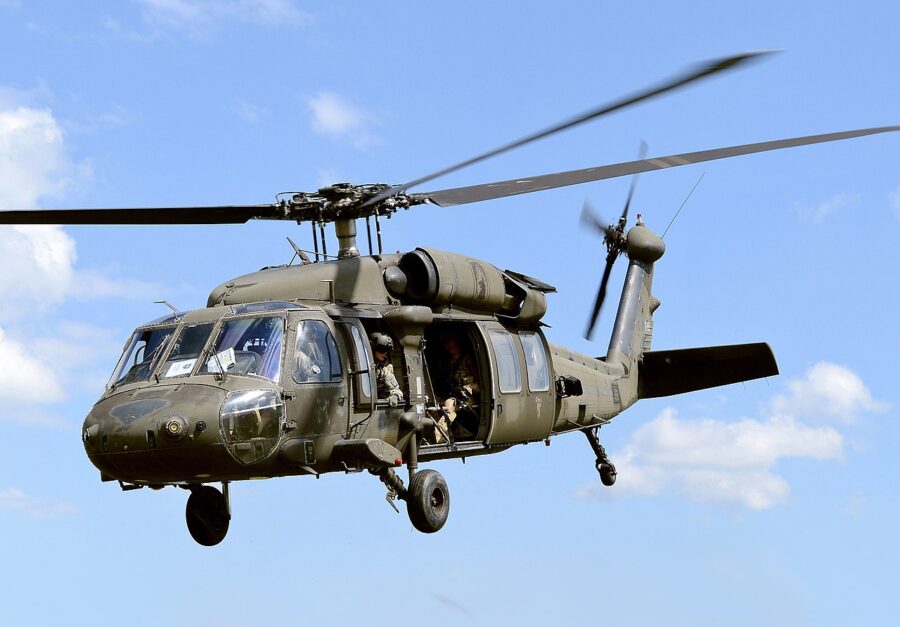

DoD photo by Gertrud Zach, U.S. Army
- Manufacturer: Sikorsky Aircraft
- Airspeed: 357 kph (222 mph)
- Capacity: 11 troops/ 6 stretchers/ 1,200 kg (2,640 lb) internal cargo/ 4,100 kg (9,000 lb) external cargo
- Range: 590 km (370 miles)
Perhaps better known for its depiction in the movie ‘Black Hawk Down,’ the Sikorsky UH-60 is one of the most recognizable utility helicopters in the army. It replaced the Bell UH-1 transport helicopter as the United States army frontline utility helicopter in 1979 with various multi-role variants equipped with electronic warfare and special operations mission capabilities.
The UH-60 Black Hawk has seen combat deployment in numerous global conflicts, including Grenada, Somalia, the Middle East, the Balkans, and Afghanistan.
NHIndustries NH90


U.S. Navy photo by Mass Communication Specialist 3rd Class David Flewellyn
- Manufacturer: NHIndustries
- Airspeed: 300 kph (190 mph)
- Capacity: 20 troops/ 6 stretchers/ 2 NATO pallets/ 4,200 kg (9,259 Ib) external load
- Range: 1,000 km (620 miles)
Introduced in 2007, the NH90 is a modern, medium-sized, utility military helicopter with multi mission capabilities. It is designed to be deployed from sea and land bases, and it is in operation with the naval and air forces of several European countries, the Middle East, and Australia.
7. Trainer Helicopter
Trainer helicopters in the military are typically variants of operational light helicopters that have been modified for pilot training. They have basic flight controls and usually have a crew of two pilots, although some training helicopter versions may have a crew of two.
Trainer helicopter types in the army do not carry weapons because they are not combating aircraft. However, attack helicopter pilots may advance to more sophisticated aircraft equipped with weapons after completing basic training in a trainer military helicopter.
Examples of trainer military helicopters
Airbus Helicopters EC635/H135M/TH-135
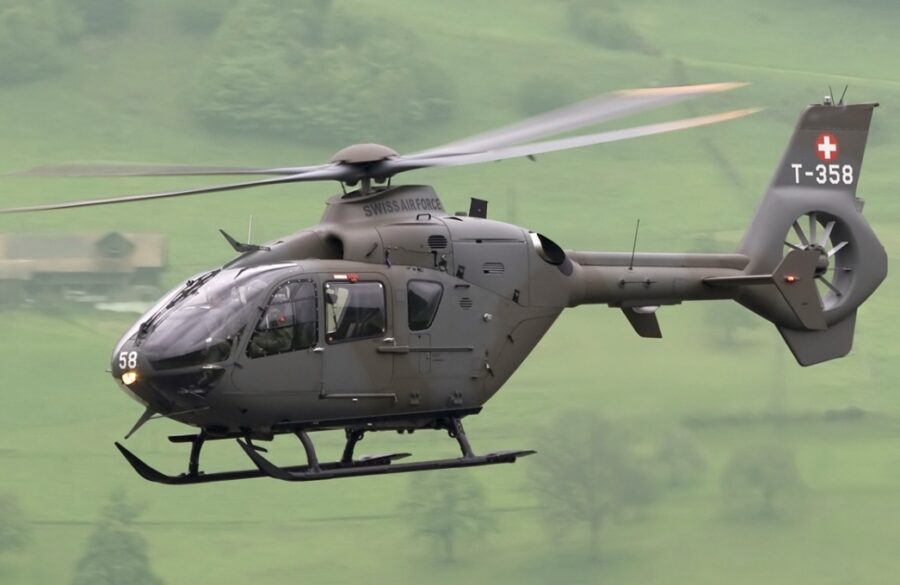

Photo by Peter Bakema
- Manufacturer: Eurocopter, Airbus Helicopters
- Airspeed: 287 kph (178 mph)
- Crew: 1
The H135M is a light military helicopter certified for military operations. Introduced in 1996, the TH-135 designation is an army training variant in service with the armed forces of several countries.
TH-73A
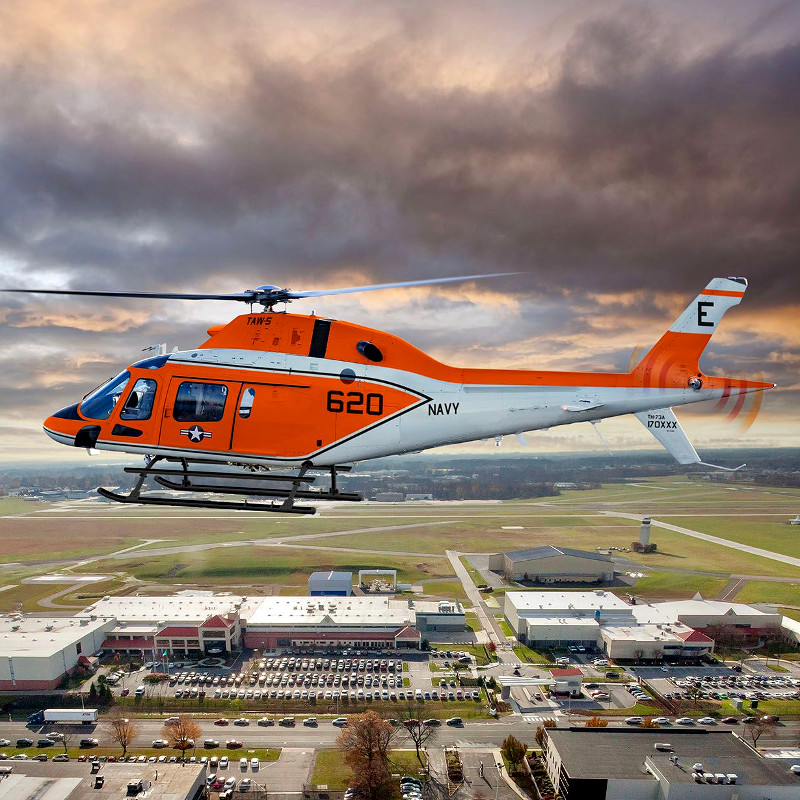

- Manufacturer: AgustaWestland
- Airspeed: 281 kph (174 mph)
- Crew: 2 pilots with seats for four students
The Advanced Helicopter Training System (AHTS) provides advanced training tools designed to incorporate the latest avionics technology and enhanced training methods for newbie pilots. The TH-73A is a modern military helicopter trainer. The TH-73A helicopter is in military service with the United States Navy, Marine Corps, and Coast Guard Pilots.
Bell TH-57 Sea Ranger
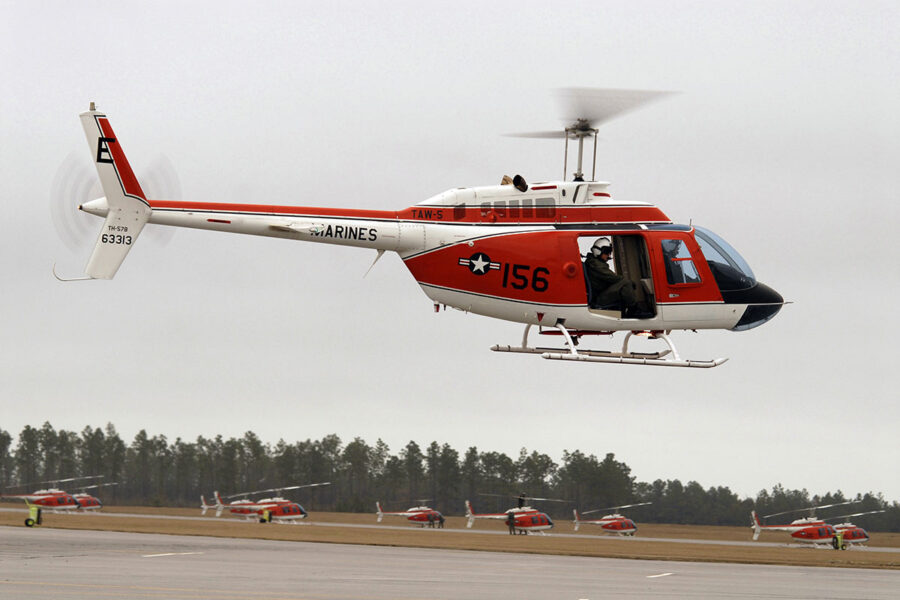

Photo by Alan Warner
- Manufacturer: Bell Helicopter Textron
- Airspeed: 210 kph (131 mph)
- Crew: 1 with seats for four students
The TH-57 Sea Ranger is a popular military helicopter used for flight training, and it is in service with the United States Marine Corps and the Navy.
Conclusion
Military helicopters will remain a vital weapon and logistics delivery platform for armed forces throughout the globe. Aeronautics engineers are constantly developing new materials designed to reduce airframe fatigue and increase the operational lifespan of modern helicopters in the army over their predecessors.
Also, equipping military helicopters with upgradeable avionics systems that can be updated through wireless or plug-in tools offers older aircraft the opportunity to remain in service without becoming obsolete.





















